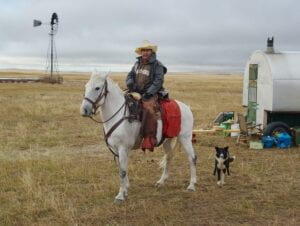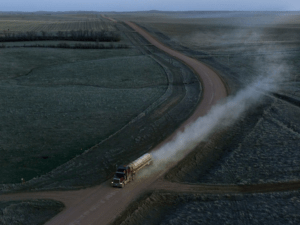Subtle Significance Along the 100th Meridian: A Review of Andrew Moore’s Dirt Meridian
By Alejandro Cortinas
The 100th Meridian: the long, wide and grand plains of the American West, marked by an invisible horizontal line, almost 100 degrees longitude west of the prime meridian, is an often forgotten and ignored middle-ground of America. It is a very desolate and spacious land that transmits feelings of isolation, both in abstraction and upon viewing. However, this area was once historically marked by the malevolent grandeur of westward expansion and manifest destiny. Specifically in the 19th century, it was associated with the attractive qualities of Colonial America as perceived by European settlers; it was as a new place, almost mystic in conception, which had the potential to foster fresh beginnings.
Today however, some century and a half later, life along and around this meridian almost feels alien to those not accustomed to it; it appears strikingly hollow, alarmingly deserted, and seemingly void of any significance to untrained eyes. But to those who know how to look at it, to those who call it home or have an appreciation for that which is overlooked: the 100th meridian is simply beautiful, and its endless and seemingly infinite nature contains all that could ever be needed. It’s “irreplaceable”, American novelist Kent Haruf said in the Preface he wrote for photographer Andrew Moore’s photo essay titled: Dirt Meridian, which somehow encompasses the essence of this seemingly infinite middle of America.
All the magnificent photographs presented throughout Dirt Meridian, which Moore began working on in 2005, and finally published in print with Damiani Editore in 2015, are a testament to these previously mentioned sentiments. The project is composed of both aerial and on-foot shots, and is made up of about 30 pictures online, and 72 in print. Astutely, the photos offer a glimpse into a reality that is often forgotten because of its spacious emptiness, and lack thereof in history post its initial craze. A reality which stretches for thousands of miles across time zones, imaginary state boundaries, native grasslands, expansive plains, rolling prairies, and the remnants of ambitious westward American expansion, be it successful or not. This glimpse is particularly encapsulated in a series of breathtaking aerial photographs that, through their composition, form a deep intimacy between their natural and artificial subjects, and the land they reside upon. They also ask the viewer to appreciate the pure simplicity and intersections of and within its frame, and seem to distract any patient observer away from the chaotic and convoluted essence of their lives, and subtly encourages them to divulge their attention into another life and land, seemingly far more simpler due to its bare and almost naked appearance, yet equally as complex, and equally as captivating and intricate when one becomes familiar with it.
A particular photograph that stands out is one of a latino man named Pedro — dressed in a cowboy hat, a hoodie, and weaver leather— positioned in the center of the frame sitting atop of a white horse with his dog to his left, his farm around him, and the American plains behind him, stretching for seeming infinity into the horizon. To me, after viewing this photo for some time, it is compelling shots such as this one in Moore’s overarching project that convey an indescribable multifaceted perception of hope and failure, an independent perception on the interconnection of nature and humanity, an exposition of why something that is not appreciated because of its conceived immediate significance should still be valued for what it is, and a longing for home. Though I am not from these plains, I am taken away by their outstretched beauty, and am immensely comforted by them.
Despite his obvious talent, Moore still needed some help to capture the sheer expansiveness of the American west as he couldn’t do so through close-up shots of the land or the people within it alone. So he hired Doug Dean, an expert Cessna 180 pilot who is credited on the title page. According to a Lens Culture article written by Moore himself, Dean and Moore “devised a means for placing a high-resolution camera on the strut of the plane, which could be remotely operated from the cockpit.” To capture low flying aerial shots that “allowed [them] to make pictures at a perspective in which the intimate seemed conjoined with the infinite”(Moore 3). Dean’s abilities allowed them to “travel to just about any location, quickly and in most weather conditions, and shoot either on the ground or from above” (3).
I found a book review by George Slade which further highlights the crucial role Dean had in Moore’s project. Specifically, Slade marvels at the prominent use of the aerial form in Moore’s work, and how influential it is, and subsequently Dean himself, because of how much land one needs to cover to fully encompass the 100th meridian in photograph. He describes how Dean’s “function, then, added aspects of scout, cartographer, historian, and meteorologist to piloting skills.” And “Not only did Dean’s plane enable Moore to preview and land near locations that would have scarcely been accessible by car, the plane opened up a critical angle on this territory” (3). Evidently enough, both according to Moore himself and reviews of his photo essay, Dean’s flying contributed immensely to Moore’s project, and perhaps without it, the extensively intimate and expansive nature of the photographs, and the “vast and sublime emptiness” of the land it covers, would not be or feel the same (Moore 5).
A photo that stands out in my mind when thinking about Dean’s presence in Moore’s photo essay is one titled “Truck at Night” of an Oil Tanker approaching an intersection, kicking up a dust cloud while on a dirt road in Nebraska. The photo appears to have been taken during the evening, and was clearly taken in flight. However, the camera appears dangerously close to the ground, and ultimately it almost feels like the photo was taken from a water tower. The shot is also just high enough to show the road the trucker has already navigated through, and how it goes on for tens of miles without end behind him. Around that single dirt road, which serves as a visual boundary on the land it crosses, the expansive plains of the American west stretch for infinity and dissipate into the horizon both on the vertical and horizontal planes of the photograph. As you can see, just through the altitude of the camera itself, and the exact aerial angle at which Moore was able to take his photo because of Dean, an evident intimacy can be felt between the truck, the road, the natural land, and the infinite setting surrounding them. What such an intimacy implies, and what it can be put into relation to, is entirely up to the viewer’s discretion and perspective.
I feel compelled to refer back to Kent Haruf’s Preface in Dirt Meridian to help summarize Moore’s work. “Andrew Moore has given us these magnificent photographs, showing the great expanses” to bring to light a particularly beautiful and intimate part of the world which is routinely ignored because of its seeming lack of life and development (Haruf 3). His photos are “clear and evocative, unsentimental,” and “seem to understand the sacredness of this country. They suggest its holiness” (3). His work also exposes the intersection of life, land, time, and encourages the viewer to leave their observations with a richer and more diverse perception of their lives and surroundings. In all, it simply asks the audience for the courtesy of a pause, and the patience to develop an appreciation for what things innately are, rather than what we wish them to be.
Pedro, Sheridan County, Nebraska, 2013. © Andrew Moore
Truck at Night, McKenzie County, North Dakota, 2013. © Andrew Moore
Works Cited
Moore, Andrew. “Dirt Meridian.” Andrewlmoore.com. Web. 12 November 2022. https://andrewlmoore.com/dirt-meridian.
Moore, Andrew. Dirt Meridian. Damiani, 2014
Moore, Andrew. “Dirt Meridian – Photographs and Text by Andrew Moore.” LensCulture. Web. 29 November 2022. https://www.lensculture.com/articles/andrew-moore-dirt-meridian.
Leifert, Harvey. “Dividing Line: The Past, Present and Future of the 100th Meridian.” Earth Magazine, 9 Jan. 2018. Web. 8 December 2022. https://www.earthmagazine.org/article/dividing-line-past-present-and-future-100th-meridian/.
Slade, George. “Book Review: Dirt Meridian.” Photoeye, 11 February 2016. Web. 22 November 2022. https://blog.photoeye.com/2016/02/book-review-dirt-meridian.html.


